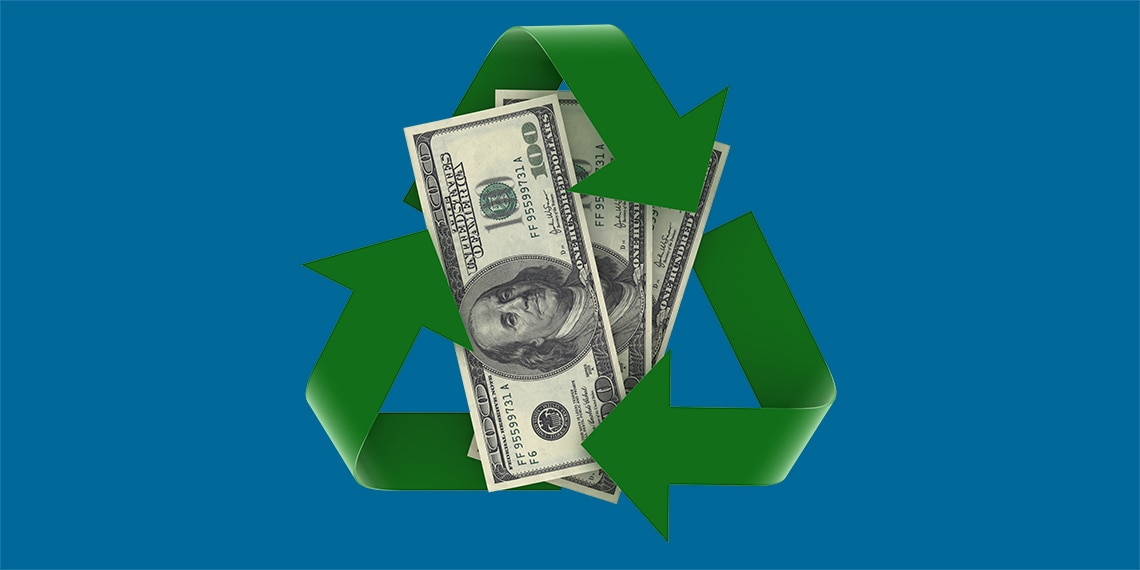
While organic foods, sustainable materials and eco-friendly cleaners are all good for the environment, they often come with higher price tags. For some people, going green is worth the extra cost. But for many of us, the trade-off can noticeably affect our bottom lines, making it a challenge to choose to be more eco-conscious.
Fortunately, there are plenty of ways to go green in your daily life without compromising your long-term financial goals. In fact, the process of reducing your carbon footprint, staying healthy and teaching important lessons to your children can actually save you money.
Want to make your home greener and save some green in the process? Here’s a room-by-room guide of strategies.
Kitchen
❏ Clean with cloth towels: Washable cloth towels can do the same work as paper towels, are better for the planet and are cheaper to use (especially for heavy cleanups)—even when taking into account the cost of washing and drying.
❏ Yes, use the dishwasher: It may seem like dishwashers require a lot of power and water, but an Energy Star dishwasher uses less than half as much energy as handwashing your dishes, saving you as much as $40 a year (plus a lot of time!).
❏ Eat less red meat: From the land cleared for cows to the fertilizers used to grow their feed to the methane gas released, cattle take a toll on the environment. Plus, red meat is expensive, and eating too much of it has been linked to health problems.
❏ BYO grocery bags: Plastic bags have a usage life of 12 minutes but an afterlife of up to 1,000 years; paper bags decompose faster but require a lot of energy to produce. Now that many cities have started charging customers for plastic bags, reusable bags are a smart way to save.
❏ Change your popcorn routine: Microwave popcorn bags are lined with chemicals, including perfluorooctanoic acid, which is bad for the air, and is used in other compounds that have been linked to cancer. Instead, make your own microwave popcorn, which is a cheaper and healthier option.
Basement/Laundry Room
Around 10% of the average home’s total electricity use goes to washing and drying clothes. Here’s how to do it more efficiently.
❏ Wash in cold water: Almost 90% of the energy used by a washing machine goes into heating the water. But in most cases, cold water does just as good a job.
❏ Clean the lint trap: When lint is blocking the trap in your dryer, it keeps moist air from escaping, so it’ll take longer to dry your clothes.
❏ Replace wisely: When it comes time to replace your washer and dryer, purchase models with the Energy Star label. Even if it costs a little more upfront, it will save you on water and electricity over time.
Bathroom
❏ Replace vinyl shower curtains: For around the same price as vinyl, you can get a polyester shower curtain. Unlike vinyl, polyester doesn’t have PVC, which releases chemicals, as well as odors. (And yes, you can wash your shower curtain in the washing machine.)
❏ Take a shorter shower: Showers account for nearly 17% of indoor water use, according to the Environmental Protection Agency. Taking shorter showers is one way of cutting down on water and energy bills. Also look into replacing showerheads with WaterSense models; just one water-efficient tap could save the average family more than $70 a year, while reducing the strain on the planet’s fresh water.
❏ Turn off the tap: Do you let the water run while brushing your teeth or shaving? Turning off the tap can save 8 gallons a day while brushing teeth and 10 gallons a day while shaving, says the EPA.
Living Room and Office
❏ Lighting: Energy-efficient light bulbs like CFLs and LEDs can use as little as 20% of the energy of incandescent bulbs, and last up to 25 times as long. While they may cost more, replacing just five bulbs with Energy Star bulbs can save you up to $75 a year, according to the Department of Energy.
❏ Use smart power strips: Anything that’s plugged in—even if it’s in sleep mode—can use energy and cost you money. Buy regular power strips and turn them off when not in use or try smart power strips, which detect when a device is in sleep mode.
❏ Cancel junk mail: Opt out of those unsolicited offers for new credit cards and insurance by using the link or calling 888-5-OPTOUT (1-888-567-8688). It may not directly save you money, but it will save you time, and saving all that paper is good for the planet.
Outside the Home
❏ Improve your car’s fuel efficiency: When driving, there are several things you can do to save on gas: drive slower, avoid hard acceleration and braking, keep empty bike racks off the roof, minimize your use of the air conditioner and keep your tires properly inflated.
❏ Water plants in the morning: Lower morning temperatures mean less water is lost to evaporation than if you water in the middle of the day or evening.
Rich Beattie is a former executive digital editor of Travel+Leisure, and has written for outlets such as The New York Times, Popular Science, New York Magazine and Ski.
Read next : How to Green Your Dream Vacation.

